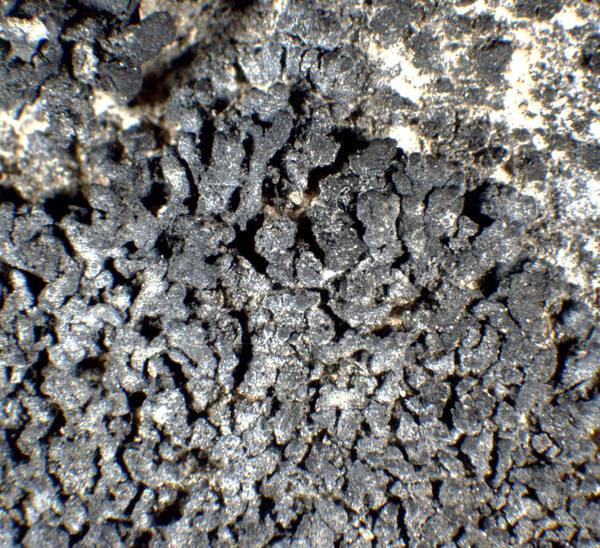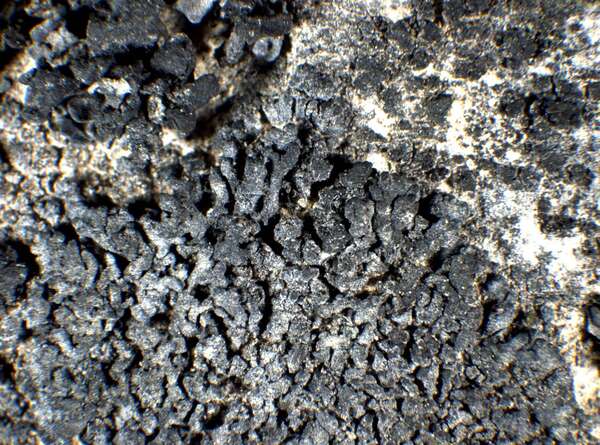Anema suffruticosum P.P. Moreno & Egea
Acta Bot. Barcinon., 41: 26, 1992.
Synonyms:
Distribution: N - TAA (Nascimbene 2002). C - Abr (TSB 30609). S - Camp (Nimis & Tretiach 2004).
Description: Thallus squamulose-subfruticose, homoiomerous, slightly gelatinous when wet, in section with a loosely reticulate network of 3-5 µm thick hyphae enclosing groups of cyanobacterial cells, consisting of small, pillow-like, lobulate and umbilicate 0.5-1.2 cm wide squamules, the surface black, but (at least in part) densely covered in a bluish pruina; peripheral lobules adpressed, flat, branched, sometimes imbricate, 300-400 µm thick; central lobules erect, cylindrical, simple or sparingly branched. Apothecia pycnoascocarps, 8-13 in each squamule, terminal on the central lobules or laminar in the peripheral ones, at first immersed and urceolate but soon expanded and clearly lecanorine, 0.5-1 mm across, with a dark reddish brown, concave to flat, often pruinose disc, and a thick, prominent, initially smooth then rugose thalline margin. Proper exciple cupular, 25-40 µm wide; epithecium yellowish, up to 25 µm high; hymenium colourless, 100-150 µm high, the hymenial gel I+ blue; paraphyses mostly simple, 3-4.5 µm thick, moniliform in upper part, the terminal cell much swollen, to 7 µm wide; hypothecium colourless, 30-100 µm high in central part. Asci 8-spored, broadly clavate, thin-walled, with a distinct amyloid outer cap, but no apical dome, Peccania-type. Ascospores 1-celled, hyaline broadly ellipsoid to subglobose, 12-15(-17) x 8-10(-11) µm, the wall 1-2 µm thick. Pycnidia immersed, globose, unilocular, 150-175 µm wide. Conidia hyaline, ellipsoid or bacilliform, 3-4 x c. 1.5 µm. Photobiont cyanobacterial, chroococcoid, of a few 7-12 µm wide cells surrounded by a gelatinous sheath which is colourless in inner parts, yellowish brown near the thallus surface. Spot tests: all negative. Chemistry: without lichen substances. Note: on sunny seepage tracks of calciferous rocks, not common, but perhaps more widespread below the montane belt.
Growth form: Crustose
Substrata: rocks
Photobiont: cyanobacteria, coccaceous (e.g. Gloeocapsa)
Reproductive strategy: mainly sexual
On otherwise dry surfaces with short periods of water seepage after rain
Commonnes-rarity: (info)
Alpine belt: absent
Subalpine belt: absent
Oromediterranean belt: absent
Montane belt: absent
Submediterranean belt: very rare
Padanian area: absent
Humid submediterranean belt: absent
Humid mediterranean belt: very rare
Dry mediterranean belt: absent

Predictive model
Herbarium samples
Growth form: Crustose
Substrata: rocks
Photobiont: cyanobacteria, coccaceous (e.g. Gloeocapsa)
Reproductive strategy: mainly sexual
On otherwise dry surfaces with short periods of water seepage after rain
Commonnes-rarity: (info)
Alpine belt: absent
Subalpine belt: absent
Oromediterranean belt: absent
Montane belt: absent
Submediterranean belt: very rare
Padanian area: absent
Humid submediterranean belt: absent
Humid mediterranean belt: very rare
Dry mediterranean belt: absent

Predictive model
| Herbarium samples |
 INDEX FUNGORUM
INDEX FUNGORUM
 GBIF
GBIF
 DOLICHENS
DOLICHENS




